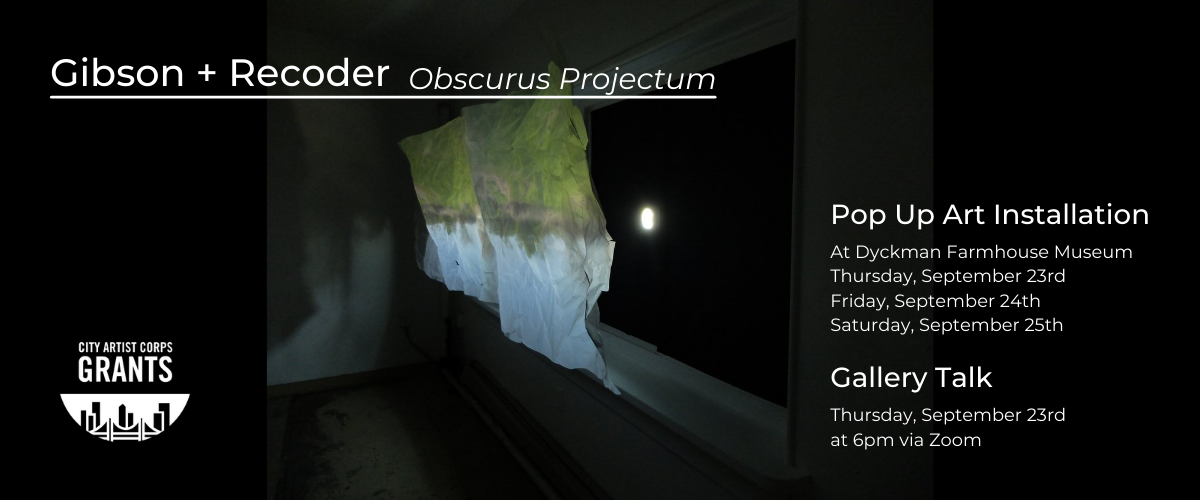
- This event has passed.
Gibson + Recoder presents Obscurus Projectum
September 23, 2021 - September 25, 2021
Free
This week we are partnered with Gibson + Recoder for a limited pop up art installation titled “Obscurus Projectum” that is on display at the Dyckman Farmhouse Museum during open hours this Thursday, Friday, and Saturday! Don’t miss the opportunity to check out this beautiful installment in person or on Zoom for a special Gallery Talk on Thursday, September 23rd at 6pm.
Gallery Talk: Thursday, September 23rd at 6pm via Zoom
Gibson + Recoder
Obscurus Projectum
Across its long history, the camera obscura has been an artistic tool, a philosophical device, a scientific implement. Each function has made the camera obscura an analog of something: the eye, human consciousness, the “outside” world itself (Gibson and Recoder call it “the earliest projection of the world, or simply world projection”). The renewed interest in the camera obscura evidenced by exhibitions like this one, and the persistence with which some filmmakers and critics work to sustain analogue moving image media, are sometimes dismissed as mere nostalgia, or contrariness for its own sake, or fetishism of technologies that have been rendered obsolete by digital. Obscurus Projectum suggests another, deeper, reason for the ongoing appeal of the analogue in the so-called digital millennium: rather than alienating us with a cryptic interior that has no “room” for us, camera obscuras – as models of analogue image-making technology in general – admit us, let us in. They make real space for our bodies rather than a virtual space we cannot inhabit. They are part of the physical world we live in. Analog and digital media both make images, of course, but the former also appeals to our tactile sense, and thus answers our desire for physical connection with our world and with those objects and other bodies with whom we share our rooms. (Jonathan Walley)
This program is made possible by the New York City Artist Corps.
Gibson + Recoder have exhibited their celebrated expanded cinema performances and installations at the Museum Kunstpalast Düsseldorf, M HKA, Serralves Foundation, EYE Film Museum, REDCAT, Mad. Sq. Art, and Ballroom Marfa. Their works are in the permanent collections of the Whitney Museum of American Art, Academy Museum of Motion Pictures, and Memorial Art Gallery. They live and work in New York. www.gibsonrecoder.com
A lo largo de su larga historia, la cámara oscura ha sido una herramienta artística, un dispositivo filosófico, un instrumento científico. Cada función ha hecho de la cámara oscura un análogo de algo: el ojo, la conciencia humana, el mundo “exterior” en sí mismo. Gibson y Recoder lo llaman “la proyección más antigua del mundo, o simplemente “proyección del mundo”. El renovado interés por la cámara oscura evidenciado por exposiciones como esta, y la persistencia con la que algunos cineastas y críticos trabajan para sostener los medios analógicos de imágenes en movimiento, a veces se descartan como mera nostalgia, o contrariedad por sí misma, o fetichismo de tecnologías que han quedado obsoletas por la tecnología digital. Obscuras Projectum sugiere otra razón más profunda para el atractivo continuo de lo analógico en el llamado milenio digital. En lugar de alienarnos con un interior críptico que no tiene “espacio” para nosotros, las cámaras oscuras, como modelos de creación de imágenes analógicas-tecnología en general, nos admite, nos deja entrar. Ellos crean un espacio real para nuestros cuerpos en lugar de un espacio virtual que no podemos habitar. Son parte del mundo físico en el que vivimos. Los medio analógicos y digitales crean imágenes, por supuesto, pero, el primero apela a nuestro sentido táctil y, por lo tanto, responde a nuestro deseo de conexión física con nuestro mundo y con esos objetos y otros cuerpos con quienes compartimos nuestras habitaciones. (Jonathan Walley).
Este programa es posible gracias al Cuerpo de Artistas de la Ciudad de Nueva York.
Gibson + Recoder ha exhibido sus célebres actuaciones e instalaciones cinematográficas ampliadas en el Museum Kunstpalast Düsseldorf, M HKA, Serralves Foundation, EYE Film Museum, REDCAT, Mad, Cuadrados Art, y Ballroom Marfa. Sus obras se encuentran en las colecciones permanentes del Whitney Museum of American Art, el Academy Museum of Motion Pictures y la Memorial Art Gallery. Viven y trabajan en Nueva York.
